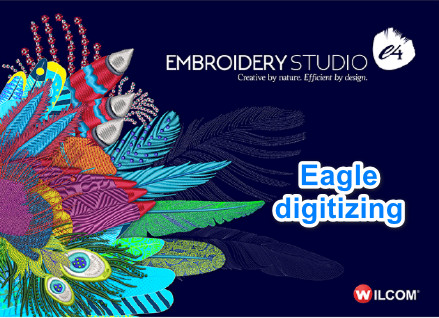Vector Art for Embroidery: The Basics You Should Know
Embroidery has evolved from a hand-crafted tradition into a precise art form with the aid of digital technology. At the heart of this modern process lies the digitization of vector art, a crucial step that transforms intricate designs into stitch files that machines can read. Understanding how to digitize vector art is essential for anyone looking to create high-quality, customizable embroidered items. This course will walk you through the basics of digitizing vector art and explain how digital files play an important part in current embroidery.
Why Digitizing Vector Art is Essential for Embroidery
Digitizing vector art is a fundamental process in modern embroidery, bridging the gap between design and production. Vector art, with its scalable and precise lines, provides the ideal foundation for creating clean, sharp embroidery designs. The digitization process converts these digital illustrations into stitch files that embroidery machines use to accurately reproduce designs on fabric. Without this step, the detailed artwork would remain confined to a screen, unable to be translated into the physical world of threads and textiles.
The Digitizing Process
What is Digitizing? Breaking Down the Basics
Digitizing is the process of converting vector art into a format that an embroidery machine can understand. This involves translating the visual elements of the artwork into stitch instructions, which include details like stitch type, direction, and density. The result is a stitch file that guides the embroidery machine in recreating the design on fabric.
From Art to Thread: How Digitizing Transforms Your Designs
The transition from vector art to embroidered design involves several steps. First, the vector image is imported into digitizing software, where it is then mapped out in terms of stitch types and paths. The software translates these paths into stitch instructions, creating a digital blueprint for the embroidery machine. This blueprint is refined and adjusted to ensure the final product meets quality standards and accurately reflects the original design.
Essential Software for Digitizing Vector Art
Several software programs are available for digitizing vector art, each offering a range of features to suit different needs. Popular options include Wilcom Embroidery Studio, Hatch Embroidery Software, and Brother PE-Design. These programs provide tools for importing vector files, designing stitch layouts, and optimizing designs for various fabrics and embroidery machines.
Preparing Your Vector Art
Choosing the Right Vector Art for Embroidery
Not all vector art is suitable for embroidery. When selecting artwork, consider factors like complexity, size, and color. Simple, clean designs with clear lines and minimal detail tend to work best. Avoid overly intricate designs or those with too many colors, as these can be challenging to reproduce accurately on fabric.
How to Prepare Your Artwork for Digitizing
Before digitizing, ensure your vector art is clean and properly organized. Remove any unnecessary elements or layers, and make sure the design is properly scaled. Simplify complex designs by reducing the number of colors and eliminating small, intricate details that may not translate well to embroidery.
Simplifying Complex Designs: Tips for Better Results
To achieve the best results with complex designs, break them down into simpler components. Focus on the most important elements of the design and consider how they will be represented in the thread. Use fewer colors and larger stitch areas to ensure that the design remains clear and legible when embroidered.
Software Setup and Tools
Setting Up Your Digitizing Software: A Beginner’s Guide
Setting up digitizing software involves installing the program, configuring settings, and familiarizing yourself with its interface. Start by importing your vector art and setting up the workspace according to your preferences. Take the time to explore the software’s features and tools, as this will help you work more efficiently and produce better results.
Key Tools and Features in Digitizing Software
Digitizing software typically includes a variety of tools for editing and creating stitch files. Key features include path editing, stitch type selection, and color management. Familiarize yourself with tools such as the stitch editor, object properties, and the preview function to enhance your digitizing skills.
Understanding Stitch Types: Satin, Fill, and More
Different stitch types serve different purposes in embroidery. Satin stitches are used for narrow, smooth areas, while fill stitches cover larger spaces with a textured pattern. Other stitch types, such as running stitches and appliqué, are used for specific effects and applications. Understanding these stitch types will help you choose the best one for your design and achieve the desired result.
Converting Vector Art to Stitch Files
Importing Vector Art: Getting Started with Your Software
Begin by importing your vector art into the digitizing software. Most programs support common file formats such as .AI or .SVG. Once imported, the software will convert the vector paths into editable objects that can be translated into stitch instructions.
Converting Paths to Stitches: How to Create the Perfect Stitch File
After importing the vector art, convert the paths into stitches by assigning stitch types and settings. Adjust the stitch density, direction, and sequence to ensure that the design is properly translated into a stitch file. Pay close attention to details like underlay stitches and thread trimmings to improve the overall quality of the embroidery.
Adjusting Settings for Optimal Stitch Quality
Fine-tuning the settings is crucial for achieving high-quality embroidery. Adjust the stitch density to ensure proper coverage without causing puckering or distortion. Modify the stitch length and width to match the fabric and thread type, and use the software’s preview function to visualize the final result before production.
Creating and Editing Stitch Files
Designing the Stitch Layout: Planning Your Embroidery
When designing the stitch layout, consider the overall structure and flow of the design. Plan the stitch sequence to minimize thread trims and color changes, and ensure that the design is well-balanced and visually appealing. Proper planning will help streamline the embroidery process and improve the outcome.
Editing Stitches: How to Fine-Tune Your Design
Editing stitches involves making adjustments to the stitch layout and settings to refine the design. Use the software’s editing tools to tweak individual stitches, modify stitch paths, and adjust density. Regularly preview your design to ensure that any changes improve the overall quality and appearance of the embroidery.
Testing and Previewing Your Stitch File Before Production
Before finalizing your design, conduct a test stitch to evaluate its performance on fabric. This will help identify any issues with stitch placement, thread tension, or design accuracy. Use the results of the test stitch to make any necessary adjustments and ensure that the final product meets your expectations.
Choosing the Right Thread and Fabric
Selecting Threads: How Color and Texture Affect Your Design
Choosing the right thread is essential for achieving the desired look and feel of your embroidery. Consider factors such as color, texture, and type of thread. Threads come in various materials, including polyester, cotton, and rayon, each with its own characteristics and impact on the final design.
Choosing Fabrics: What Works Best with Your Digitized Art
The choice of fabric can significantly affect the outcome of your embroidery. Choose fabrics that are compatible with your design and thread type. Consider factors such as fabric weight, texture, and stability when selecting materials to ensure that the embroidery looks crisp and professional.
Understanding the Impact of Fabric Type on Your Design
Different fabrics can influence the appearance and durability of your embroidery. Heavier fabrics like denim or canvas may require different settings and techniques compared to lighter fabrics like cotton or silk. Understanding the impact of fabric type will help you make informed decisions and achieve the best results with your digitized designs.
Optimizing for Embroidery Machines
Machine Compatibility: Ensuring Your File Works with Different Machines
Embroidery machines come in various makes and models, each with its own file format requirements. Ensure that your digitized file is compatible with the machine that will be used for production. Most software programs allow you to save files in multiple formats to accommodate different machines.
Adjusting File Formats for Different Embroidery Machines
When preparing your file for different embroidery machines, be aware of the specific format requirements. Common file formats include.DST, .EXP, and .PES. Adjust the file settings as needed to ensure compatibility and optimal performance with the target machine.
Understanding Machine Settings: What You Need to Know
Familiarize yourself with the settings of the embroidery machine to ensure that your digitized file is executed correctly. Adjust settings such as thread tension, hoop size, and stitch speed to match the requirements of your design and fabric.
Quality Control and Testing
The Importance of Testing Your Digitized Art
Testing your digitized art is crucial for ensuring that your design translates well onto fabric. Conducting test stitches helps identify any issues with stitch quality, design accuracy, and fabric compatibility. Use test results to make necessary adjustments and achieve the best final product.
How to Conduct a Test Stitch: What to Look For
When performing a test stitch, evaluate factors such as stitch density, alignment, and thread tension. Check for issues like puckering, thread breaks, and misalignment. Use the test stitch to refine your design and settings before proceeding with the final production.
Making Adjustments Based on Test Results
Use the feedback from your test stitch to make adjustments to your digitized file and machine settings. Address any issues with stitch quality, thread tension, or design accuracy to ensure that the final embroidery meets your standards.
Saving and Exporting Your Files
Saving Your Digitized Design: Best Practices for File Management
Save your digitized design in multiple formats to ensure compatibility with different embroidery machines and software. Use descriptive file names and systematically organize your files to facilitate easy access and management.
Exporting to Different Formats: What You Need to Know
When exporting your digitized design, select the appropriate file format for your embroidery machine. Common formats include.DST, .EXP, and .PES. Ensure that the file is properly formatted and ready for production by checking compatibility and settings.
Preparing Files for Client Delivery or Production
Prepare your files for client delivery or production by providing them in the required formats and ensuring that they are properly labeled and organized. Include any necessary instructions or specifications to facilitate a smooth production process.
Digitizing vector art for embroidery is an intricate process that combines artistic vision with technical precision. By understanding the basics of vector art, mastering the embroidery digitizing process, and utilizing advanced techniques, you can create stunning embroidered designs that bring your ideas to life. Embrace the opportunities to experiment and practice, and continue to refine your skills to achieve excellence in your embroidery projects. The journey from digital art to thread is both rewarding and creative, offering endless possibilities for personalization and expression.



